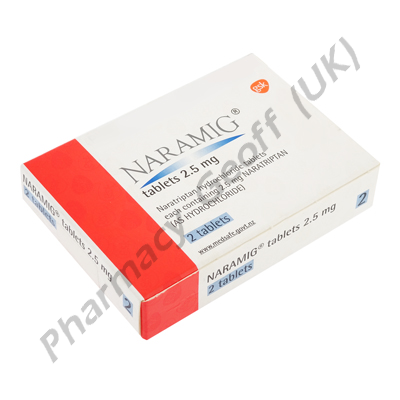
Our price: £25.00
Naramig (Naratriptan)
Naramig (Naratriptan) Uses
Naramig (Naratriptan) is used to relieve migraine attacks with or without aura.
Naramig (Naratriptan) is a selective serotonin 5-HT1 receptor agonist. These receptors are located mainly in the intracranial blood vessels (in the brain and dura mater). Stimulation of receptors leads to vasoconstriction. Naratriptan has a high affinity for 5-HT1b and 5-HT1d subtypes of human serotonin 5-HT1 receptors. It is believed that the stimulation of 5-HT1B receptors leads to a narrowing of the intracranial blood vessels.
It has little or no effect on other subtypes of serotonin 5-HT receptors (5-HT2, 5-HT3, 5-HT4, and 5-HT7). Based on experimental studies, it is assumed that the basis of the anti-migraine action of naratriptan lies in its ability to cause selective narrowing of blood vessels in the carotid arteries (supplying extracranial and intracranial tissues with blood, in particular, the meninges), as well as inhibiting the trigeminal nerve.
Naramig (Naratriptan) Dosage and Administration
Always follow your doctor`s instructions when using Naramig (Naratriptan) to get the safest and most effective results from treatment.
With the development of a migraine attack, Naramig (Naratriptan) should be taken as early as possible, although the drug is effective in the later stages of an attack. Tablets should be taken whole with water. For adults 18-65 years old, the recommended oral dose is 2.5 mg (1 tab). The maximum dose is 5 mg.
If, after the initial reduction of symptoms, they reappear, a second dose may be given with an interval of at least 4 hours between the two doses. If the symptoms of migraine do not disappear or do not decrease after taking the first dose of Naramig (Naratriptan), then you should not take the second dose to stop the same attack. The drug can be used to relieve subsequent migraine attacks.
Do not exceed the recommended dose. For patients with impaired liver function, the maximum daily dose is 2.5 mg.
Naramig (Naratriptan) Side effects
The use of Naramig (Naratriptan) may cause side effects including:
- Dizziness
- Nausea
- Vomiting
- Weakness
- Drowsiness
- Feeling of pain and pressure in the throat and neck
- Spasm of the coronary vessels
- Impaired peripheral circulation
- Paresthesia
Naramig (Naratriptan) Precautions
In patients with renal and hepatic insufficiency, the daily dose should not exceed 2.5 mg. Not recommended for the prevention of migraine (with the exception of menstrual).
Naramig (Naratriptan) should not be used within 24 hours after using other triptans or ergotamine and similar drugs. During the period of treatment, it is necessary to refrain from driving and working with potentially dangerous mechanisms that require increased attention and speed of reaction.
Naramig (Naratriptan) increases the effect of sedatives. Ergotamine and other anti-migraine preparations increase the likelihood of side effects.
Pregnancy and lactation
The safety of Naramig (Naratriptan) during pregnancy has not been established; therefore, it should be prescribed only in cases where the expected benefit to the mother greatly exceeds the possible risk to the fetus.
Use with caution during lactation. The results of experimental studies indicate the absence of direct teratogenic or damaging effect of naratriptan on the peri-and postnatal development of a child.




 Categories
Categories